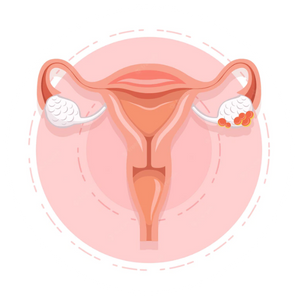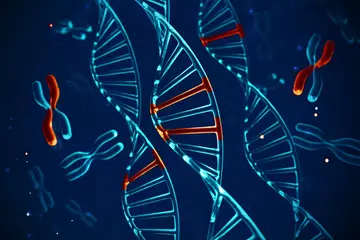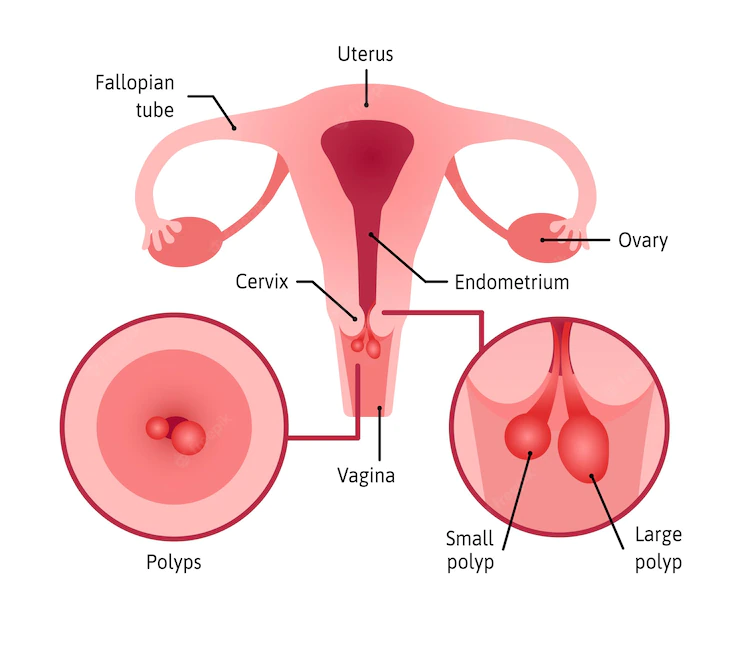Ovarian Cancer
Ovarian cancer is a type of cancer that affects the ovaries, which are the organs in a woman’s body that produce the ovum. It usually occurs in older women but can also happen in younger women who have a family history of the disease. Ovarian cancer can start in one of the fallopian tubes and then spread to the ovary.
About Ovarian Cancer
The ovaries are the organs responsible for conception. The 2 ovaries lie on either side of the uterus. A Fallopian tube from each ovary carries the ovum to the uterus. Ovarian cancer is one of the most common gynaecologic malignancies seen in women.
It is usually seen in elderly women, after the age of 60. The majority appear to be sporadic, but a proportion possess a hereditary component, arising as a result of high-risk mutations passed on from one generation to the next. The hereditary ovarian cancers arise in the younger age groups with the incidence increasing after the age of 35, and a large number being seen in the 40s and 50s.
It is believed that an ovarian cancer originates initially in one of the fallopian tubes and then spreads into the ovary. One or both ovaries can be involved with the cancer at presentation.
Ovary cancer can be of different histopathology types, with high grade serous carcinoma being the commonest. Other types like mucinous, clear cell and endometrioid types can also occur.
Ovarian cancer can be high or low grade on pathology. It can be borderline or invasive in nature. High grade serous adenocarcinomas of the Fallopian tube and the Peritoneum behave similar to an advanced Ovarian Cancer. They are identical in pathology and require the same treatment.
Early-stage ovary cancer can be cured, advanced stage ovarian cancer can be controlled but not cured.
A combination of chemotherapy and surgery are both required in the treatment of ovarian cancer.
How to look for signs of ovarian cancer?








Ovarian cancer is a disease that develops gradually over months to years; it initially has subtle signs and symptoms that may require a high index of suspicion to diagnose the cancer.








Early symptoms include gradual loss of appetite, weight loss, and weakness, which may be followed by abdominal pain, bloating, early satiety/feeling of fullness, and increased frequency of urination with urinary urgency.








Development of these symptoms should prompt urgent sonography of the abdomen, followed by CT scan or a whole-body PET-CT scan to determine the extent of the cancer and check for metastasis.








A CA-125 level blood test can be used for monitoring, but it should not be relied on for diagnosis alone as it can be elevated in benign conditions or remain normal in some ovarian cancers.








As the disease progresses, abdominal distension and ascites may occur, a spread to the lungs can cause pleural effusion and breathlessness, liver involvement can cause jaundice.








The cancer may also be detected through postmenopausal vaginal spotting or bleeding.








In the advanced stages, a CT or USG-guided biopsy from one of the lesions seen on imaging is needed to confirm the diagnosis and plan treatment.
Causes of Ovarian Cancer ( Risk Factors)


Hereditary factors
Ovarian cancer can be passed on from one generation to the next, and having a family history of ovarian cancer in a mother, grandmother, sister, or other first or second-degree relatives increases the risk of developing the cancer in the future.


Age
Increasing age is another risk factor for ovarian cancer, with the risk increasing as a woman grows older.


Breast cancer
Ovarian cancer shares a close link with breast cancer, and
having a personal or family history of breast cancer increases the risk of
developing ovarian cancer.


Menarche and menopause
Early menarche (11 or younger) and late menopause (53 or older) both carry an increased risk of ovarian cancer.


Genetic component
Ovarian cancer has a strong genetic component with there being many mutations that predispose to its development at an early age. BRCA1 & BRCA2 are common high-risk mutations. Other rare mutations exist that also increase the risk.


Nulliparity
Nulliparous women (women who have not given birth) carry a higher risk for ovarian cancer.


Endometriosis
Endometriosis is postulated to carry a small increase in the risk of ovarian cancer.


Other rare causes
Exposure to asbestos and a prior history of pelvic radiation for the treatment of another cancer can also increase the risk of ovarian cancer.
Ovarian Cyst vs Ovarian Cancer
Ovarian cysts are benign, fluid-filled sacs in the ovary that can occur in women of all ages and can be of various types. They can be asymptomatic or can cause abdominal pain. They are not life-threatening and do not usually develop into a cancer. Complex cysts may be cancerous and require further evaluation. Ovarian cysts can be diagnosed with a pelvic ultrasound. In general, an ovarian cyst does not require treatment and can resolve spontaneously, but if it increases in size, causes pain, is complex or appears suspicious for a cancer, then surgical treatment may be required.


Ovarian Cancer Symptoms
What are the symptoms of Ovarian Cancer?
Gradual loss of appetite
Nausea, vomiting and increased frequency of urination
Postmenopausal vaginal spotting or bleeding
Vague abdominal pain or discomfort


Unexplained weight loss
Abdominal mass, ascites, breathlessness, pleural effusion.
Abdominal bloating and feeling of fullness
Weakness
Ovarian Cancer - Diagnosis and Treatment
- A complete physical examination must first be performed. Abdominal tenderness, any abdominal or pelvic mass, abdominal distension, presence of any inguinal lymphadenopathy, ascites, and pleural effusion must be looked for.
- Development of the above signs and symptoms should prompt urgent sonography of the abdomen. This is usually suggestive of an ovarian abnormality.
- It must be followed by a CT scan of the Chest, Abdomen, and Pelvis, or a whole-body PET-CT scan to see the extent of the cancer and as a metastatic workup. The PET scan will also ascertain the status of the liver and the lungs, whether they have been involved with cancer or not, and help determine the appropriate line of treatment.
- A CA-125 level is one of the blood tests that can be used for monitoring and assessing response to treatment if elevated initially. It will be elevated in the majority of serous ovarian cancers. However, it can be elevated in other benign pelvic conditions. It may also remain normal in some ovarian cancers like mucinous adenocarcinoma. Therefore, it must not be relied on solely for diagnosis.
- A CT or a USG-guided biopsy from one of the lesions seen on imaging is then required to confirm the diagnosis and plan the treatment. An omental or a peritoneal lesion can be biopsied. If Ascites is present, an ascitic fluid sample may be sent to check for malignant cells.
- It is essential to remember that if the cancer is localized to the ovary, without any other signs of spread, a CT or a USG-guided biopsy of the ovary must not be attempted. This risks spillage of cancer cells into the peritoneal cavity, therefore causing cancer spread. The entire ovary then must be surgically removed.
Request an Appointment at Dr. Sujata Vasani's Clinic
Ovarian Cancer Risk Reduction And Prevention
It is now known that ovarian cancers can be hereditary, occurring as a result of high-risk disease-causing mutations.
These mutations are transmitted from generation to generation and are commonly inherited from one of the parents. The mutations can be transmitted by the father or mother.
The high-risk mutations are BRCA1 & 2, BRIP1, RAD51C, RAD51D, and those associated with Lynch Syndrome, which occurs due to deficiencies in the the Mismatch Repair Genes.
BRCA1 carries a 35-45 % lifetime risk of Ovarian Cancer.
BRCA2 carries a 13-23% lifetime risk of Ovarian Cancer.
The risk of developing an ovarian cancer for these women increases after the age of 35, although some patients may be diagnosed in their early 30s.
A risk reduction surgery, known as a Bilateral Salpingo-oophorectomy by the age of 35-40 or earlier if child-bearing is complete, is recommended for these women.
This surgery involves the removal of both ovaries and fallopian tubes.
It is the most effective treatment to reduce the risk of ovarian and fallopian tube cancer in women carrying these lethal mutations.
When performed early, before the age of 50, the risk of Breast Cancer is also reduced for these patients.
Performing a hysterectomy in women diagnosed with Lynch Syndrome also reduces their risk of developing a mutation associated Endometrial Cancer.


PCOS or Polycystic Ovarian Syndrome
This is a benign condition involving the ovary that generally develops during adolescence.
It is one of the most common causes of infertility in women.
Its cause is unknown, but it primarily results in ovarian dysfunction.
It is characterised by:
- Polycystic ovaries- may involve one or both ovaries.
- Obesity which results in insulin resistance, predisposes to the development of Diabetes, Heart Disease, and increases the future risk for the occurrence of Endometrial Cancer.
- Menstrual complaints like irregular bleeding/periods, oligomenorrhoea, or amenorrhea ( absence of periods ).
- Excessive secretion of Androgens that causes heavy growth of hair- hirsutism, and development of pimples or acne-which can be moderate to quite severe, and can be resistant to treatment.
Each symptom seen has to be treated individually.
The diagnosis is suspected
When a girl around the age of 15-16 years, gives a history of irregular periods, excessive weight gain or obesity, acne which is resistant to treatment & heavy hair growth over the body, especially the face.
An ultrasound of the pelvis showing polycystic ovaries will lead to the diagnosis.
Treatment
Depends on the principal complaints. Weight loss is usually required, especially in adolescent girls and adults who are keen on a pregnancy.
Oral contraceptives which consist of a combination of estrogen & progesterone are usually the first line treatment suggested, especially if a lady desires pregnancy or in girls with hyperandrogenism/excessive secretion of androgens that result in heavy hair growth.
Metformin tablet may be used as second line treatment in women who cannot take oral contraceptives. It can also be used in women with Diabetes and impaired glucose tolerance. Besides controlling the sugar, it helps in reducing the blood pressure & aids in weight loss.
Treatment of Ovarian Cancer
Ovarian cancer can be divided into three principal types
Epithelial ovarian cancer-of which high grade serous carcinoma is the type commonly diagnosed in the majority of women with ovarian cancer.
Borderline ovarian cancer- of which low grade serous cancer is the most common.
Germ cell ovarian cancers- usually found in the younger age group.
For all the above histopathological types, in the early stages of the cancer, when the tumour is still confined to the ovary, a complete surgery that removes all visible cancer, with lymph node dissection, omental & peritoneal clearance is required.


In Epithelial Ovarian Cancer
Stage 1
ovarian cancer means that the cancer has not spread outside the ovary, though both ovaries can be involved.
if the tumor is low grade and there is no spread outside the ovary, no further treatment is needed post surgery.
However, if the tumor is high-grade, chemotherapy post-surgery is required.
Stage 2
ovarian cancer means the cancer has spread outside the ovary into the surrounding organs and tissues. However, it is still confined to the pelvis and has not spread into the abdomen.
Such patients require a complete surgery followed by 6 cycles of adjuvant chemotherapy.
Ovarian cancer when detected in stages 1 & 2 and treated promptly can be cured completely
Stage 3 ovarian cancer means there is an invasion into the abdomen, and omental & peritoneal deposits are seen with lymph node involvement. With cancer progressing, Ascites or fluid collection in the abdomen occurs. This fluid may require removal when it accumulates in a large quantity.
Stage 3 cancer patients have advanced disease. They require 6 cycles of chemotherapy up-front for disease control and reduction. After chemotherapy, surgery is indicated if all visible disease can be completely cleared.
Stage 3 ovarian cancer patients cannot be cured, the cancer can be controlled & suppressed but frequent recurrences every few years are common, and such patients require repeated cycles of chemotherapy & targeted therapy for disease control.
However, with the new treatment options available, stage 3 cancer patients can lead a good quality of life, maintaining their daily routine, with an extended survival.
Stage 4 ovarian cancer means there is spread into the major organs like the liver & lungs. These patients cannot be cured and generally do not benefit from surgery. They are treated with a combination of chemotherapy and targeted therapy which allows effective disease control. They experience repeated disease relapses and require multiple chemotherapy treatment lines for disease control. However, chemotherapy is extremely effective in this cancer. Most patients do well on treatment and will maintain a good quality of life. Chemotherapy gives them an extended life span.
The chemotherapy drugs used in the first line of treatment are Paclitaxel & Carboplatin in all stages. Bevacizumab is a targeted therapy that is added to chemotherapy in stage 4 patients.
All high-grade and clear-cell ovarian cancers require chemotherapy irrespective of the stage they are diagnosed in.
All ovarian cancer patients must undergo molecular profiling to detect high-risk, disease-causing mutations like BRCA1 & BRCA2, and to detect defects in the DNA repair mechanisms.
Stage 3 and 4 cancer patients who carry the above mutations/defects can be put on oral maintenance with PARP Inhibitors like Olaparib, Rucaparib & Niraparib. This helps in prolonging survival for these patients and giving them longer breaks off chemotherapy.
Ovarian Borderline Tumours
These are ovarian cancers of low malignant potential. They are usually serous on histopathology. They are usually diagnosed in the early stage and can be cured completely.
A complete surgery is recommended in all stages, to clear all visible disease.
Chemotherapy is required only if invasion is detected in the histopathology sample after surgery.
Germ Cell Tumours
These are a type of ovarian cancer seen in younger patients, usually between 10-30 years of age.
These patients require a complete cytoreductive surgery to remove all viable disease.
Most of them will also require adjuvant chemotherapy. 4 cycles of chemotherapy are usually administered as per the BEP regimen, using Bleomycin, Cisplatin and Etoposide.
Know about suitable treatment options from Dr. Sujata
Frequently Asked Questions
It is not possible to check for ovarian cancer at home as it cannot be physically felt by the patient. Its signs and symptoms are subtle and non-specific. It is best to consult a Medical Oncologist if ovarian cancer is suspected.
Yes, if detected in the early stages, when the cancer is confined to the ovary, it can be cured completely with the appropriate treatment.
Ovarian cancer is of various types like Epithelial- which is the type commonly seen, Germ Cell Tumours of the Ovary, Borderline Ovarian Cancers and Sex Cord Stromal Tumours of the Ovary. High grade Serous Adenocarcinoma of the Ovary is the commonest type of Epithelial Ovarian Cancer diagnosed. Mucinous, Clear Cell & Carcinosarcomas are the other types also seen in lesser frequency.
Cancer that arises within one or both ovaries, is called ovarian cancer. These are present on either side of the uterus, to which they are connected by the fallopian tubes. They produce the ovum which is required for pregnancy or conception.
Loss of appetite followed by weight loss, fatigue and weakness are the initial signs of ovarian cancer. These are followed by a vague abdominal or pelvic pain which gradually extends to involve the entire abdomen. Nausea, vomiting, urinary urgency, increase in frequency of urination, occasional vaginal spotting presenting as post-menopausal bleeding, bloating, early satiety, feeling of fullness and indigestion are the other signs of ovarian cancer.
A family history of ovarian cancer, a personal or family history of breast cancer, older age, a person carrying high risk hereditary mutations like BRCA1 & BRCA2 are all risk factors for ovarian cancer.
Older age itself predisposes to ovarian cancer. The presence of hereditary, high risk mutations like BRCA1, BRCA2, BRIP1, RAD51C, RAD51D are all known to cause ovarian cancer. They are transmitted from generation to generation, from one of the parents to the children.
Ovarian cancer is usually detected in the advanced stages, which may be stage 3 or 4. Stage 4 ovarian cancer cannot be cured but it can be well controlled using a combination of chemotherapy, targeted therapy and oral tablets. There is no role of surgery. Appropriate medicines can allow a patient to lead a good quality of life, remain symptom free and have an extended life span.
There is no vaccine currently for prevention or treatment of ovarian cancer.
Patient Case Studies
Case studies provide valuable insights into the treatment and management of individual cancer patients, informing oncologists’ decision-making and helping to improve care and outcomes for all patients. They also inform clinical guidelines and best practices, benefiting all cancer patients
Patient Testimonials
A Leading Ovarian Cancer clinic in Mumbai
Take the first step towards better treatment by reaching out to the expert team at the Ovarian Cancer clinic in Mumbai. Schedule a consultation today!


